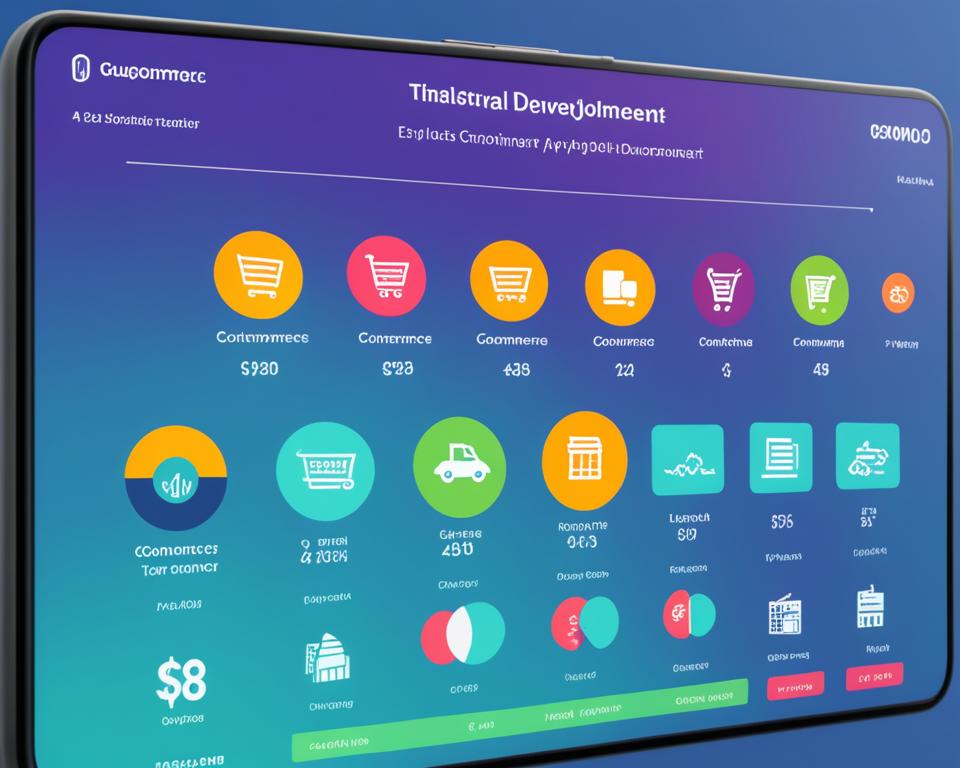In today’s fast-paced online world, knowing the cost to make an e-commerce app in India is key for businesses wanting a strong online presence. This guide explores the factors that affect the price of creating an e-commerce app in India. It offers insights to help you make smart choices for your online store project.
The cost to build an e-commerce app in India changes a lot. It depends on the project’s size, the features you need, how complex the app is, and the skills of the team. Knowing these factors is vital for setting a budget and making sure your e-commerce project succeeds.
Table of Contents
Key Takeaways
- The cost of making an e-commerce app in India changes based on the app’s complexity, features, and the team’s skills.
- Choosing skilled developers means your project will be done well and you’ll get a good return on your investment.
- Using existing frameworks and libraries can cut down on the cost of making your e-commerce app.
- Good planning and understanding what you need from your project are key to keeping costs under control.
- Choosing to outsource your e-commerce app development to India can give you a cost advantage.
Understanding the Scope of E-commerce App Development
Creating a full e-commerce app means knowing what users need. This includes things like signing up, showing products, and managing orders. E-commerce app development in India focuses on these key parts to make a strong, easy-to-use app.
Core Features and Functionalities
Key parts of e-commerce app development are:
- User registration and login
- Product catalog with detailed descriptions, images, and pricing
- Shopping cart and checkout process
- User profiles and order history
- Admin dashboard for managing products, orders, and customer data
- Payment gateway integration for secure transactions
- Push notifications and in-app messaging
- Inventory management and order fulfillment
Integrations and Third-Party Services
For a full e-commerce solution, you need to work with other companies and services. These can be:
- Shipping and logistics providers for order fulfillment
- Payment gateways for secure online transactions
- Tax and accounting software for financial management
- Customer relationship management (CRM) tools for managing leads and customer data
- Analytics and reporting platforms for data-driven insights
| Feature | Importance | Impact on Cost |
|---|---|---|
| User registration and login | High | Moderate |
| Product catalog | High | Moderate to High |
| Shopping cart and checkout | High | Moderate to High |
| Payment gateway integration | High | Moderate |
| Inventory management | High | Moderate |
Knowing what features an e-commerce app needs helps businesses plan and budget for their projects. This ensures they cover the essential e-commerce app functionalities and add the right third-party integrations for e-commerce apps.
“The scope of e-commerce app development is vast, encompassing a wide range of features and functionalities that are essential for delivering a seamless shopping experience.”
E-commerce App Development Cost in India: An Overview
The cost of making an e-commerce app in India varies a lot. It can go from approximately ₹5 lakhs to ₹50 lakhs. On average, it costs about ₹15 lakhs to ₹25 lakhs.
Many things affect the price of e-commerce app development in India. These include the app’s features, the technology used, the team’s skills, and how long the project takes.
Let’s dive into the main factors that change the cost:
- App complexity and the number of features
- Integration with third-party services and APIs
- The experience and expertise of the development team
- The chosen development approach (in-house vs. outsourcing)
- Ongoing maintenance and support requirements
Knowing these factors helps businesses understand the price range for e-commerce app development in India. This way, they can plan their budgets better.
“The cost of e-commerce app development in India is heavily dependent on the specific needs and requirements of the project. While the average range provides a good starting point, it’s crucial to carefully assess all the contributing factors to arrive at an accurate estimate.”
Factors Influencing the Development Cost
The cost of making an e-commerce app in India depends on several things. These include how complex the app is and what features it needs. It’s important for businesses to know these cost drivers to make a successful e-commerce platform.
App Complexity and Features
The complexity of an e-commerce app greatly affects its cost. Apps with advanced features like real-time inventory management, personalized product recommendations, or multi-language support cost more. The need for integration with third-party services, custom design and user interface, and scalability also play a big role in pricing.
Other factors like the number of user roles and access levels, the complexity of the checkout process, and the integration of payment gateways add to the cost. Businesses should think about what they really need and pick the most important features. This helps balance the cost with the app’s functionality.
“The key to managing e-commerce app development costs is to strike the right balance between features, functionality, and budget. Businesses must carefully evaluate their priorities and work with experienced developers to create a cost-effective solution that meets their specific needs.”
Team Composition and Hourly Rates
In India, the team behind e-commerce app development is key to the project’s cost. It includes experienced developers, designers, and project managers. Each has their own hourly rate, affecting the budget.
Developer Experience and Expertise
The skills and experience of the developers matter a lot for e-commerce app development costs in India. Seasoned developers with a strong background in this field charge more. They have the skills and knowledge needed. Junior developers, though, might charge less but could take longer and cost more overall.
| Developer Expertise | Hourly Rates (in INR) |
|---|---|
| Junior Developer | 800 – 1,200 |
| Mid-level Developer | 1,200 – 2,000 |
| Senior Developer | 2,000 – 3,500 |
Choosing the right team is crucial for e-commerce app development in India. It helps control costs and ensures the app’s success.
E-commerce App Development Cost in India
Typical Cost Ranges
When looking at the cost of making an e-commerce app in India, many things matter. The app’s complexity, the team’s skills, and the way it’s made all affect the price. Let’s explore these factors.
A basic e-commerce app with simple features like a product catalog and payment gateway can cost between ₹5 lakhs to ₹15 lakhs. But, if the app needs more advanced stuff like managing stock or real-time data, the price can go up to ₹20 lakhs to ₹50 lakhs.
The team’s skills and the tech they use also change the price. Hiring a team of senior developers will cost more than a team of mid-level or junior developers. Using the latest tech or needing special skills can also make the app more expensive.
| App Complexity | Typical Cost Range (INR) |
|---|---|
| Basic E-commerce App | ₹5 lakhs to ₹15 lakhs |
| Advanced E-commerce App | ₹20 lakhs to ₹50 lakhs |
Knowing these cost ranges helps businesses plan their budgets. It helps them make smart choices when investing in their online growth.
Breakdown of Development Costs
Understanding the costs of e-commerce app development in India is key. The costs are spread across several areas, each vital for a successful app. These areas include design, backend, frontend, testing, and deployment.
Design and User Experience
The look and feel of an e-commerce app matter a lot. It needs to be easy to use and nice to look at. Designers work hard to make sure users have a great experience.
Backend Development
The backend is where the app stores data and talks to other systems. It’s a big part of the cost. Developers use tech like Node.js or Python to make it work well.
Frontend Development
The frontend is what users see and interact with. It’s important for a good user experience. Developers use frameworks like React to make it look good and work smoothly.
Testing and Quality Assurance
Testing makes sure the app works right and is safe. It includes checking how fast it is and if it’s secure. This part needs special skills and tools.
Deployment and Hosting
After making the app, we need to put it on servers and make it available to users. This includes servers, CDNs, and cloud services. These costs add up.
| Cost Component | Percentage of Total Cost |
|---|---|
| Design and User Experience | 20-30% |
| Backend Development | 25-35% |
| Frontend Development | 20-30% |
| Testing and Quality Assurance | 10-15% |
| Deployment and Hosting | 5-10% |
Knowing how e-commerce app development costs in India break down helps businesses plan better. It helps them use their money wisely and make smart choices.
Choosing the Right Development Approach
When developing an e-commerce app, businesses face two main choices: building it in-house or hiring a specialized agency. Each method has its pros and cons, affecting the project’s cost.
In-House vs. Outsourcing
Building an e-commerce app in-house gives you full control and a custom solution. But, it needs a skilled team, which is costly and time-consuming to keep up. Outsourcing to a trusted agency uses their know-how and saves money, making the process quicker and cheaper.
| Factor | In-House Development | Outsourcing |
|---|---|---|
| Cost | Higher upfront costs for hiring and maintaining a dedicated team | Generally lower development costs, but may include additional fees for project management and coordination |
| Expertise | Requires building an in-house team with the necessary skills and experience | Leverages the expertise and specialized knowledge of the outsourcing agency |
| Flexibility | Allows for greater control and customization, but can be less flexible in scaling up or down | Offers more flexibility in scaling the development team and resources as needed |
| Time to Market | Typically longer, as building an in-house team and developing the app can be a time-consuming process | Potentially faster, as the outsourcing agency can dedicate a team and resources to the project |
When deciding between in-house vs. outsourcing e-commerce app development in India, think about your budget, timeline, tech skills, and future goals. Weighing these factors helps you choose the best approach for your business. This ensures a successful e-commerce app development journey.
E-commerce App Development Cost in India: A Competitive Advantage
Building an e-commerce app in India can save a lot of money compared to other places. This makes it a great choice for businesses wanting a strong online presence without spending too much. The benefits of making e-commerce apps in India are many, and the low cost can really change the game for businesses of all sizes.
One big plus is the skilled and affordable workers in India. Indian developers are experts in new technologies and charge less than those in North America or Europe. This means businesses can save a lot of money, which helps them spend more on other important parts of their business.
India also has a strong startup scene that offers many e-commerce app development agencies and freelancers. These experts know the Indian market well and can make apps that meet the needs of Indian e-commerce businesses. Their skills and low prices make India a top choice for making e-commerce apps.
Another benefit is the wide range of talent available in India. Indian developers are flexible, eager to learn, and quick to adopt new technologies. This lets businesses create powerful, scalable, and feature-rich apps that can compete with global companies. All this can be done at a low cost.
“Partnering with an Indian e-commerce app development team has been a game-changer for our business. We’ve been able to build a cutting-edge platform that resonates with our customers, all while staying within our budget. The level of expertise and attention to detail has been truly impressive.”
In summary, the benefits of making e-commerce apps in India are clear. The low cost, skilled workers, and strong startup scene make India a great place for businesses to grow online. By using India for e-commerce app development, companies can get ahead and succeed in the fast-changing e-commerce world.
Strategies to Optimize Development Costs
Reducing the cost of e-commerce app development in India is possible with smart strategies. Using existing frameworks and libraries is a key approach. This method speeds up development and cuts down on custom coding needs.
Leveraging Existing Frameworks and Libraries
Using pre-built frameworks and libraries saves time and resources. These tools handle common tasks like user login, payment, and stock management. This lets developers work on what makes the app special. Choosing the right parts of these solutions is a smart way to save money.
Open-source frameworks and libraries are also worth looking into. They offer many features without extra cost. These tools can help start the development quickly, reducing the need for custom work and saving money.
| Framework/Library | Features | Potential Cost Savings |
|---|---|---|
| React.js | User interface, state management, performance optimization | Reduces development time and effort |
| Laravel | Web application framework, database integration, authentication | Streamlines development process and minimizes custom coding |
| Stripe | Secure payment processing, fraud detection, subscription management | Eliminates the need for in-house payment processing development |
By using these frameworks and libraries, businesses can lower the cost of making e-commerce apps in India. They also get to use the knowledge and support from these established solutions.
Maintenance and Support Costs
Launching an e-commerce app is just the beginning. Businesses must also plan for ongoing costs to keep the app running well and safely. These costs are key to budgeting for the app’s life cycle.
Keeping an e-commerce app up to date means doing regular tasks. These include software updates, bug fixes, security patches, and performance optimizations. These ongoing maintenance and support costs for e-commerce apps are important to consider when planning.
To plan for budgeting for e-commerce app lifecycle costs, think about these factors:
- Hosting and infrastructure costs, like server maintenance and cloud storage fees
- Ongoing software licensing and subscription fees for third-party integrations
- Dedicated support team and their salaries, including developers, designers, and QA specialists
- Regular software updates, security patches, and bug fixes
- Performance optimization and scalability enhancements
- Customer support and helpdesk expenses
By planning for these ongoing maintenance and support costs for e-commerce apps, businesses can keep their e-commerce platform successful and sustainable.
The e-commerce world is always changing. To stay competitive, businesses need a strong, reliable app. Understanding and planning for all e-commerce app lifecycle costs helps make smart decisions and use resources well to reach long-term goals.
E-commerce App Development Cost in India: A Case Study
Let’s look at a real example of how much it costs to make an e-commerce app in India. This example shows the specific needs, challenges, and costs for a big e-commerce brand in India.
Shoppie, an e-commerce company, wanted a top Indian app development agency to make a strong mobile app. They aimed to improve customer experience, make buying easier, and boost sales and revenue.
| Project Requirement | Description | Estimated Cost (in Indian Rupees) |
|---|---|---|
| UI/UX Design | Comprehensive design of the app’s interface and user experience | ₹3,00,000 |
| Core Functionalities | Product listing, shopping cart, payment gateway integration, order management | ₹6,50,000 |
| Advanced Features | Personalized recommendations, push notifications, loyalty program, AR-based product visualization | ₹4,00,000 |
| Backend Development | Scalable and secure server-side infrastructure | ₹3,50,000 |
| Testing and Deployment | Comprehensive quality assurance and app store submission | ₹1,00,000 |
| Total Estimated Cost | ₹18,00,000 |
This case study shows the costs of making an e-commerce app in India. It lists all the parts and their prices. Knowing this helps businesses plan their budgets and make smart choices for their e-commerce apps.
The story of Shoppie’s app in India shows the need for a thorough and strategic plan for app development. By thinking about the app’s features, how they work together, and the skills needed, businesses can make a successful and affordable e-commerce app.
Tips for Successful E-commerce App Development
Creating a successful e-commerce app in India needs a strategic plan. This plan should cover project management, making sure everyone is on the same page, and checking quality. Here are some key tips for starting your e-commerce app development project.
Define Clear Project Goals and Scope
First, define your project goals, who you want to reach, and what features your app should have. This makes a strong base and keeps your development focused on your business goals.
Learn more about setting up your.
Establish Effective Communication and Collaboration
Good communication is key with your team, stakeholders, and users. Have regular meetings, give feedback, and quickly solve problems. This keeps everyone informed and the project moving smoothly.
Prioritize User Experience (UX) and Design
For your e-commerce app to succeed, it must be easy to use and look good. Use user research, prototypes, and design improvements to make a smooth customer journey.
Implement Robust Testing and Quality Assurance
Testing your app during and after development is crucial. It ensures your app works well, runs fast, and is safe. Have a testing plan that includes different types of tests to catch any issues.
Continuous Improvement and Maintenance
The e-commerce world changes fast. So, always listen to user feedback, look at data, and update your app as needed. Set aside resources for fixing bugs, adding new features, and keeping your app competitive.
By using these tips, you can handle e-commerce app development in India well. This will help you create a strong and engaging app for your customers.
Conclusion
This article has given a detailed look at what affects the cost of making e-commerce apps in India. It shows how the scope, team, and strategies to save costs help businesses make smart choices. This way, they can use the benefits of making their e-commerce apps in India.
Understanding the cost of e-commerce apps in India is key. It’s about knowing the app’s complexity, the skills of the developers, and how to develop it. This ensures a project that is both successful and cost-effective. Businesses can save money by using existing frameworks and keeping maintenance costs low. They can also use the competitive edge of the Indian market.
With the insights from this article, businesses can confidently move forward in the e-commerce app development scene in India. This will help them in their digital growth and reach their investment goals.














